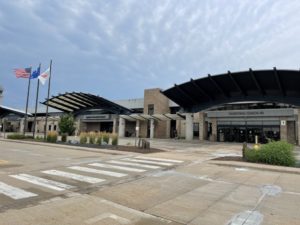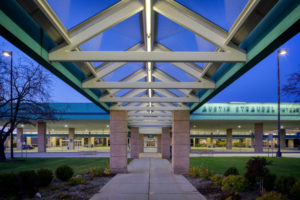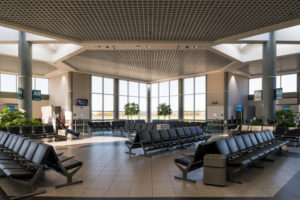Taking off!
Area airports offer first-class service at a whole new level
July 2019 was a great year for aviation. Passenger numbers were high and overall, worldwide airports were on the right trajectory. But like many industries, it has its ups and downs (pun intended). There’s a cycle that experts say happens approximately every ten years, lending itself to a fluctuating climate that is impossible to control. Enter the global pandemic of 2020.
Through it all, and especially recently, our local airports have made outstanding updates to their existing facilities, have built new ones and are keeping our community’s safety and well-being at the forefront. They’re also poised for growth, and that only means good things for the Fox Cities and beyond.
Appleton International Airport (ATW)
 Vision: “The ATW team will use a people-centered approach to provide our community superior aviation facilities, custom solutions, continuous economic development and a proactive workforce that enhances our reputation as judged by our customers, employees, board members, and region.”
Vision: “The ATW team will use a people-centered approach to provide our community superior aviation facilities, custom solutions, continuous economic development and a proactive workforce that enhances our reputation as judged by our customers, employees, board members, and region.”
The self-monikered “Fun Airport,” (they have an ice cream bus they call their secret weapon!) Appleton International Airport lives up to the nickname, but will always take one thing seriously: serving passengers.
“What I’m most proud of from an airport perspective is just our general impact on the community,” Abe Weber, Airport Director, says. “Appleton Airport exists to serve our local community. We have dedicated professionals who take pride in making travelers’ experience fast, easy and convenient.”
“We’re proud to offer the best customer experience possible being that hometown airport right in people’s backyards,” Hollie Foley, Marketing & Communications Coordinator, adds. “We truly care about our travelers and what their needs are, what their wants are.”
A big part of that comes in the form of air service flight offerings. ATW has new nonstop routes to Nashville, Savannah and Charlotte, and an increase in flights to Las Vegas and Phoenix. Denver is also back on the list after a pause due to the pandemic. The airport expects air service to continue to grow with continued increase in travel.
“On the business side, we’ve seen some additions with Gulfstream Aerospace,” Weber explains. “We’re almost finishing up a $7 million dollar facility renovation. It’s where they bring the aircraft out of Savannah… craftsmen and women finish that aircraft from the exterior and interior. It’s the world’s leading corporate business jet manufactured right here in Appleton. It’s very exciting for us to have Gulfstream on our air field.”
Their newly rebranded fixed-base operator, Appleton Flight Center, offers hangar space and hosts general aviation and things like fueling, de-icing and ground handling for the airlines.
Along with a new air ionization system that charges and encapsulates ions to filter out airborne pathogens, ATW utilizes autonomous floor scrubbers and touchless payment options so staff can focus on high traffic areas to ensure a safe and clean environment.
TSA PreCheck and new credential authentication system makes it even easier to go through TSA, and Appleton Airport has implemented two services that focus on travelers’ ability to get where they need to go quickly:
ATW Express Curb to Gate promises passengers with carry-on luggage and TSA PreCheck to get dropped off at the curb and be to their gate in 15 minutes or less.
ATW Valet Express Park allows travelers to park at the front curb, drop off their keys at a checkpoint and get to the gate with no hassle. Simply leave your keys and a cell phone number and your vehicle will be waiting for you upon your return.
“It’s all through text, you can even pay through text,” Weber says. “When you arrive from your trip, your car is waiting for you right on the curb and your keys will be there waiting for you. It’s $8 a day, the same daily rate as our long-term parking.”
“People have said, ‘It’s like your staff was watching the plane and waiting for me to land because my car was just waiting for me!’” Hollie laughs. “We get a lot of great feedback on it.”
ATW’s mission of providing guests with a “healthy, clean experience” takes form in less conventional ways like the Flex Farm, a self-contained hydroponic farming system within 15-feet of the airport restaurant that uses its produce. They’re also looking at future autonomous food and beverage options to ensure travelers will have access to good food and coffee amidst the nationwide labor shortage.
 The future is bright for Appleton International Airport. Opening in March 2022 is the new Allegiant Maintenance and Crew Base, bringing with it jobs, flights and opportunity.
The future is bright for Appleton International Airport. Opening in March 2022 is the new Allegiant Maintenance and Crew Base, bringing with it jobs, flights and opportunity.
“The great thing from our perspective about that is it hits two of our goals: it’s a $50 million investment from Allegiant so you have the economic impact with 66 new high-paying jobs,” Weber says. “For our local community it means you’re going to see new flights to our current Allegiant destinations. The flights are going to have better timing… we’re excited about future opportunities there.”
Additional future projects include growing the airport concourse and growth in their business parks to help with economic development.
“People ask ‘Why fly local?’ and it’s the same exact principle as why you shop local,” Weber says. “You keep the money in your local community. We’re your friends and neighbors, and you want to support your friends and neighbors.
“Every time you fly out of Appleton Airport you’re also giving a vote of confidence to our air carriers that service is important here. We’ve seen some growth in the last five/six years and that’s all because our community has supported our airport.”
Green Bay Austin Straubel International Airport (GRB)
 Vision: “Our vision is to be the airport of choice for Northeast Wisconsin. Our mission is to go the extra mile to provide the best quality customer experience for our passengers and airport visitors that is delivered with a sense of community pride, hospitality and care. We will do this by focusing on Operations, Marketing and Communications, Customer Experience and Community Alignment.”
Vision: “Our vision is to be the airport of choice for Northeast Wisconsin. Our mission is to go the extra mile to provide the best quality customer experience for our passengers and airport visitors that is delivered with a sense of community pride, hospitality and care. We will do this by focusing on Operations, Marketing and Communications, Customer Experience and Community Alignment.”
Environmental stewardship and airports aren’t typically a natural pairing, but Green Bay Austin Straubel International Airport is trying to change that.
“Brown County as a whole has a pretty strong initiative toward sustainability and environmental stewardship. The airport is no different,” Marty Piette, A.A.E., Airport Director, says. “We understand that we’re a pretty heavy user of natural resources so we have gone through a process of studying our efficiencies at the airport.”
Energy efficient updates include replacing all incandescent lighting to LED inside the terminal building and focusing on other best practices to minimize the airport’s impact, including the use of surrounding land and water.
Austin Straubel is currently in the final phase of becoming certified to the standards of the Alliance for Water Stewardship (AWS).
“Some of the things we can do to proactively minimize our impact on water quality are agricultural best practices,” Piette explains. “We have a lot of excess property around the airport that we lease to farmers. There are ways that farmers can farm operationally that is better for the environment. So we have a 1,000 acres of farmed property that is now being managed better from a water quality standpoint.
“We will be the first airport in the world that is certified to the Water Stewardship standard. It’s normally breweries and farms. We’re proud of it!”
Austin Straubel worked with EnTech to add the fifth-in-the-state solar powered electric vehicle charging station to their parking lot.
“Most charging stations are still powered by the grid, but this is 100% clean energy,” Piette says. “We worked with EnTech to give them an opportunity to demonstrate the technology and the fact that this can work in Wisconsin.”
 Austin Straubel has updated several practices due to COVID to be as convenient and safe as possible. Piette says “some you see, some you don’t.”
Austin Straubel has updated several practices due to COVID to be as convenient and safe as possible. Piette says “some you see, some you don’t.”
“It’s a completely touchless operation from the minute you pull into the parking lot. Your tickets automatically spit out… you can have your boarding pass on your phone,” he says. “We’ve installed a number of UVC lighting sterilization units within the terminal building.
“We also were the first airport in the state to install a NoviSphere Air Filtration System. It pulls in air and through a series of baffles and UVC lighting, it sterilizes the air and then pushes it out the other end. So it’s continuously circulating the air.”
Future projects include both functional and aesthetic: the update of boilers and HVAC systems to ensure the buildings are more efficient, spurring the ability to potentially use alternate sources of power; parking lot improvements, such as rebuilding and reconstructing the entry roads to the airport and rehabilitating their longest runway. Plus a facelift in the form of painting the outside of the terminal building.
Piette is mindful that travelers chase lower fares and nonstop flights, but insists Austin Straubel prices and the price of convenience and ease are competitive.
“Take all of the factors into account before you drive to Chicago,” Piette urges. “How much is your time worth, driving there and back. How much is the hotel night because your flight leaves at 6 in the morning in Chicago? What’s the difference in the price of parking? When someone drives somewhere else, they’re demonstrating that that city can support that service.”
Why is it important to have an airport in the relatively small community of Green Bay? Piette says it’s largely to do with business development and further growth of the city.
“One of the first things that businesses will look at before they either expand their current operations or enter a new market is transportation connectivity,” he says. “It’s air, it’s rail, by land and water.
“That’s exactly what we do. It’s literally one-stop connectivity to any point in the world.”
Five major airlines operate out of Austin Straubel: American Airlines, United, Delta and most recently Frontier Airlines and Sun Country Airlines.
Piette counts TSA Precheck, free wireless internet, close parking with low long-term rates, a gift shop and restaurants both before and post-screening as reasons to fly out of GRB. And, maybe most Wisconsin of all: a cheese shop.
“The restaurants have been completely remodeled and rebranded,” he says. “They’re more reflective of Green Bay. It’s more local flavor than just a sterile airport cafe. There’s a Green Bay Packers mural, all-new menus using locally sourced ingredients from Neuskes and Maplewood. You can’t go wrong!”
Wittman Regional Airport (OSH)
 Vision: “To be the vibrant gateway to our community, building upon our legacy as a center of aeronautical innovation and be a year-round destination for the modern aviator.”
Vision: “To be the vibrant gateway to our community, building upon our legacy as a center of aeronautical innovation and be a year-round destination for the modern aviator.”
While Wittman Regional Airport in Oshkosh hasn’t offered scheduled airline service since 2003 and is perhaps most well-known for EAA AirVenture, they’re busy those other 51 weeks of the year too. So much so, in fact, that they’re currently the busiest general aviation airport in the state of Wisconsin.
General aviation includes different sectors of aviation that fall outside of airline service—commercial passenger flights—and military aviation. It includes corporate air travel, flight training, aeromedical services, agricultural applications, charter flights and private individuals who have their own airplane at the airport.
“In 2019, we had 77,000 + aircraft operations, which we measure by takeoffs and landings,” Jim Schell, C.M., Airport Director, says. “About 15 to 20,000 on average is during AirVenture week. But if you took that out, we still had 60,000 operations the remainder of the year: more than 1,000 a week.”
Wittman’s biggest operating categories are flight training and business travel, holding a number of based organizations that use aircraft for business purposes.
Three flight training operators also currently utilize Wittman Regional Airport for their needs: Fox Valley Technical College, offering two-year programs with flight ratings from commercial pilot to aircraft mechanic, and private schools Discover Flight and Aviation Services. Basler Flight Service shares the new General Aviation Terminal Facility, offering charter flights to businesses and the general public.
“You’d be surprised to find out how cost-effective it can be if you have 4 or 5 people that are splitting the cost of the flight,” Schell says. “You can really take off here and land at any other public use airport in the country. The possibilities are almost endless.”
Beginning in 2013 and officially designed in 2016, Wittman Regional Airport’s new 12,500-square foot General Aviation Terminal Facility had its ribbon cutting ceremony on June 30, 2021. It takes the place of the two older buildings that were demolished for the $5.5 million ($1.5 million under budget!) project.
“Now there’s space for further redelevopment,” Schell says. “The plan is to build larger hangars—transient, corporate type hangars—for aircraft that are primarily coming through and spending a couple nights here for business purposes… our next goal for hangars is building smaller units to accommodate more people based at the airport.”
Wittman Regional Airport has a unique set of challenges that no other airport—regionally or worldwide—is tasked with considering on a yearly basis: the highly anticipated and successful EAA AirVenture.
 “We have to balance our 51 weeks out of the year operation with the one week of the year when we’re the busiest airport in the world,” Schell explains. “It’s a very interesting challenge of making sure we can set this airport up for future growth to meet aviation demands yet still helping that event to continue to grow. All while being the best airport we can be.”
“We have to balance our 51 weeks out of the year operation with the one week of the year when we’re the busiest airport in the world,” Schell explains. “It’s a very interesting challenge of making sure we can set this airport up for future growth to meet aviation demands yet still helping that event to continue to grow. All while being the best airport we can be.”
That includes looking forward.
“Right now we’re keeping very in touch with the latest and greatest in aviation technology. The next kind of cutting edge technology beyond just electric aircraft is urban air mobility. There are so many different options, cutting edge technologies that are being pioneered right now. Before the end of our lifetime, you will see autonomous air taxi. It’s crazy, but it’s coming.
“Unfortunately we didn’t have AirVenture in 2020 but it did allow us to complete a $7.5 million reconstruction of our biggest taxiway last year.”
Taxiway Alpha was widened ten feet to ensure enhanced safety. All lights were converted to LED, surrounding drainage was improved and they were able to complete it in one calendar year, a rare feat because of the downturn in aviation service due to the pandemic.
“We’re not slowing down!” Schell exclaims. “We’re about 75% of the way through a master plan update… we’re looking at all of the various land areas of the airport. What are the highest and best uses of those areas?”
“Between the airport, the tenants, our education partners, we want people to know that this is an open, welcoming place to come and learn about aviation. And if you’re so inclined, learn how to fly. Come out to the airport, the world-class EAA Museum. See what we’re doing and be proud of having this right here in the backyard.”










Leave a Comment